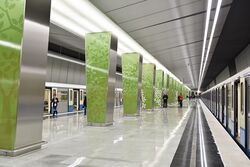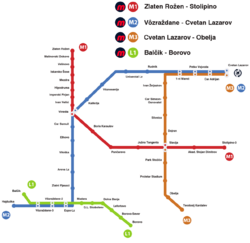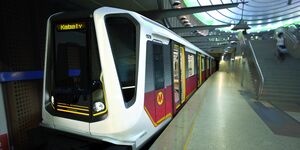Lozinetz metro
This article is incomplete because it is pending further input from participants, or it is a work-in-progress by one author. Please comment on this article's talk page to share your input, comments and questions. Note: To contribute to this article, you may need to seek help from the author(s) of this page. |
 | |||
 | |||
| Overview | |||
|---|---|---|---|
| Native name | Lozinečki metropoliten | ||
| Owner | Lozinetz Metropoliten EAD | ||
| Locale | Lozinetz, Romellea | ||
| Transit type | Rapid transit | ||
| Number of lines | 4 | ||
| Number of stations | 47 | ||
| Daily ridership | 317,000 (2019) | ||
| Chief executive | Krasimir Sergejev | ||
| Headquarters | 121, Balevurov blvd. | ||
| Website | Lozinetz traffic.rf | ||
| Operation | |||
| Began operation | 31 January 1995 | ||
| Operator(s) | Lozinetz Metropoliten EAD | ||
| Number of vehicles | 113 | ||
| Technical | |||
| System length | 36.65 km (22.8 mi) | ||
| Track gauge | 1,435 mm (4 ft 8 1⁄2 in) standard gauge | ||
| Electrification | Third rail, 825V | ||
| Average speed | 55 km/h (34 mph) | ||
| Top speed | 80 km/h (50 mph) | ||
| |||
The Lozinetz Metro (Lozinečki metropoliten, also colloquially called Lozinečko metro) is the rapid transit network servicing the Romellenic major city Lozinetz. It began operation on January 31, 1995. As of July 2019, the Lozinetz Metro consists of three interconnected subway lines and one light rail line, serving 47 stations, with a total route length of 36.65 kilometres (22.77 mi). The Metro links the densely populated districts of Zlaten Rožen – Stolipino (Line 1 – Red), Vôzraždane - Cvetan Lazarov (Line 2 - Blue), Cvetan Lazarov - Slivnica - Obelja (Line 3 - Orange) and Balčik – Borovo (Light Rail Line 1 – Light Green). The metro has a connection to a fast monorail line travelling to Lozinetz International Airport at station Cvetan Lazarov.
The Lozinetz metro system is the newest in Romellea, it was planned in the first half of the 1990s, and its construction began in 1993, with the first line being open on 31st of January 1995. Since then the subway system has been extended several times; a second line connecting the southwest and the northeast boroughs of the city was opened in 1999. In 2001, a monorail service was established between the Lozinetz International Airport and the city, with a transfer to the subway on the last station of Line M2. The new fast monorail made the access to the airport, located 25km away from the city, far easier for the majority of foreign passengers, and succeeded the older bus shuttle connection, which by early 2000s was already obsolete and overloaded.
In 2001-2003, a project for a third line operating in the eastern districts of Lozinetz was accepted, and in the course of 28 months, 13 stations were constructed. The line was opened on October 2003.
The last major extension of the rail system was made in 2009 when the boulevards Grigorij Skobelejev and Car Samuil were widened, the lines of trams 25 and 13 were separated and reconstructed into fast tram rails, and a number of shallow tunnels were constructed between the Expo-Lozinetz trade centre and Boulevard Grigorij Skobelejev. The project was converted from fast tram to light rail in 2011, and transferred under the authority of the Lozinetz Metropoliten from the city municipality. In March the line was inaugurated as the fourth and currently the last line of the system.
Since 2015, a fifth line is planned to run from the north of the city through the historical centre and the Lozinetz arena to the southeast. The line was approved and the construction of the northern branch to the centre has started in 2018. The city municipality is currently discussing the possible construction of a ring line in the centre of the city, as well as the extension of the M2 line up to the airport to reduce the load on the monorail line.
History
The liberal rule of Ivan Zhelyazkov opened Romellea to the western world for the first time since the September Revolution. In his politics, Lozinetz held a major place as the face of the country in front of the western politicians and tourists. Investitions into the city were growing, and in 1960 they had reached a mark of 7.6% of the whole income of the country. The transit system of the city was constantly upgraded, its streets and boulevards were laid with the most expensive and often imported asphalt. The public transport used both the finest domestic vehicles and even some imported western ones, something unseen on the east side of the Iron Curtain.
During the reign of Zhelyazkov, however, the city remained a historical and recreational sight, and its population did not exceed 325,000 people. Everything changed in the 1970s, with the new economic politics of xxx, when the construction of new household districts in the south began. Lozinetz experienced the same process as Samaryansk, it's population grew nearly twice in a matter of 3 years, and had reached the mark of 518,000 inhabitants in 1973. The city kept growing in the next 5 years, to eventually reach 679,000 in 1978.
Such growth showed that a new rapid transit system would be required in the next decade. The administration planned a metro system in 1977, consisting of one line connecting the historical centre with the southern boroughs of the city, with a length of 9.80 km and approximately 7 stations. The plan was approved by Sredetz and construction had to commence in 1979. The August uprisings of 1978, however, halted all plans, and the following financial instability of the early 1980s put an end to all projects not only in Lozinetz, but all around Romellea.
The city kept growing, however, with millions of Romelleans leaving the countryside in the seek for better opportunities and payment in the big cities. The population of Lozinetz reached its peak in 1986, at 723,000. Public transport became overloaded, which led to an increase in cars and the resulting air pollution. Even during the financial crisis, however, Lozinetz remained a major tourist attraction, and kept accumulating higher income than most other Romellenic regions. During the late 80s, the Romellenic government decided to attract international business into the city by moving strategic offices and factories into its vicinity. Such a move required a serious upgrade of the public transport system, thus the old metro project was revived and revised.
The project received federal status and in 1991 the first plans were presented to the public. They were approved in 1992, and in 1993 the construction of the first line began. Unlike the original plans of 1979, now the line connected two major districts in two ends of the city with its historical centre and the industrial area. Still, the line was constructed next to the old town, but not in it, due to the numerous historical layers and old sewage systems below the historical centre.
Lines
Infrastructure
Railways
Depots
Trains
Lifts and escalators
Wi-Fi and network coverage
Lines
| Line | Opened | Current Lenght | Current Number of Stations | U/C Stations | Planned Stations |
|---|---|---|---|---|---|
| M1 | 31.01.1995 | 9.6 km | 15 | 0 | 18 |
| M2 | 21.11.1999 | 11.8 km | 18 | 0 | 24 |
| M3 | 09.10.2003 | 10.3 km | 13 | 0 | 13 |
| L1 | 17.03.2011 | 4.95 km | 10 | 0 | 10 |
| M4 | U/C | 14.02 km (planned) | 0 | 9 | 27 |
Line M1 - Red
| Color | Line Bullet | Termini | Connections | Full Name | Rolling Stock | Gauge | Length km | |
|---|---|---|---|---|---|---|---|---|
| Red | 
|
Zlaten Rožen Residental area |
Stolipino-3 Residental area |
Station Vinedia to Station Slavija to |
Zlaten Rožen-Stolipino line | 
|
Standard gauge | 9.6 km |
The Red M1 line was the first to be planned and constructed in the system. It was approved by the city municipality and transferred to federal supervision in 1991, and its construction commenced in 1993. According to the plan, the construction was separated into two stages, north-centre and southeast-centre.
Works on stage one from the residential area of Zlaten Rožen with the historical centre, and consisting of 9 stations, were made between March 1993 and October 1995. It was inaugurated and launched on the 31st of January 1995.
The construction of the second diameter from the centre to the residential area Stolipino commenced one year later, in March 1996. In the course of 23 months, until February 1998, 6 new stations and a 4.5 km-long track were built and connected the historical centre with Pančarevo industrial zone, the southern section of Lozinetz ring road and the residential area of Stolipino-3. The line was opened by the Prime Minister of Romellea on 5th of May 1998, with the first stock completing the whole route with passengers one week later.
The new line received 2 depots, one situated between stations Malinovski Dokove and Velinovo, and one maintenance depot constructed below Loven Park. The whole project had an estimated cost of 338,96 billion korone (152 billion USD). It served the most-densely populated southeastern part of the city, while also served as a connection for tourists arriving from the Northern bus terminal, leading them to the city centre.
Line M2 - Blue
| Color | Line Bullet | Termini | Connections | Full Name | Rolling Stock | Gauge | Length km | |
|---|---|---|---|---|---|---|---|---|
| Blue | 
|
Cvetan Lazarov Industrial area |
Vôzraždane Residental area |
Station Cv. Lazarov to Station Car Adrijan to Station Petko Vojvoda to Station 1-vi Mareć to Station Vinedia to Station Expo-Lozinetz to Station Vôzraždane-2 to Station Vôzraždane-3 to |
Cvetan Lazarov-Vôzraždane line | 
|
Standard gauge | 11.8 km |
Parallel to the construction of the first line, the city municipality presented a project for "Realisation of the further extension of the Lozinetz metro by opening a second metro diameter", linking the northeastern and southwestern parts of the city through the centre and with one connection to Line M1, at station Vinedia. The total cost of the project was estimated at 416,92 billion korone (186,96 billion USD), 23% more than the cost of the first metro diameter. Only 12.5% of the financing came from the city budget, 5.92% from private investments, and the rest of the expenses was covered by the federal budget of Romellea. Unlike the first line, M2 was the first line with complete accessibility on every station.
The project was approved in 1997 and the realisation began in June the same year. The plan called for the construction of the line in two stages, starting in the northeast to the centre, and then from the centre to the southwest. The decision was made to open the northeastern part first, and to start a shuttle bus line between the station Cvetan Lazarov and the Lozinetz Airport. The bus line was planned as a stopgap until the city could afford a more efficient transport system to the airport. The first stage was completed in 14 months, and was completed in August 1998.
The second stage of the project was started in September 1998. According to the general plan, this part of the line had to be 5,91 km long, and consist of 8 stations. It was completed after 13 months, and the whole line was inaugurated on 21st of November, 1999. The Blue line is currently the longest line in the system (excluding the Lozinetz-Airport monorail), and has the biggest number of stations. Its construction was the most expensive metro project in Romellea since the decommunisation.
Line M3 - Orange
| Color | Line Bullet | Termini | Connections | Full Name | Rolling Stock | Gauge | Length km | |
|---|---|---|---|---|---|---|---|---|
| Orange | 
|
Cvetan Lazarov Industrial area |
Obelja Residental area |
Station Cv. Lazarov to Station Car Adrijan to Station Petko Vojvoda to Station 1-vi Mareć to |
Cvetan Lazarov-Slivnica-Obelja line | 
|
Standard gauge | 10.3 km |
Line L1 - Green
| Color | Line Bullet | Termini | Connections | Full Name | Rolling Stock | Gauge | Length km | |
|---|---|---|---|---|---|---|---|---|
| Green | 
|
Balčik Recreational area |
Borovo Residental area |
Station Vôzraždane-3 to Vôzraždane-2 to Station Expo-Lozinetz to |
Zlaten Rožen-Stolipino line | 
|
Narrow gauge | 4.95 km |
Proposed lines and extencions
Line M4
Ring Line
M2 extension to Lozinetz Airport
Light rail line extension
Night service
Travelling
Ticketing
The price of a single ticket is 5 korone (2.2 USD). Tickets can be obtained from vending machines on every station, box offices on some stations, or online through the metro ticket app, after which they should be validated upon entry of a station, within 30 minutes after their purchase (online-obtained tickets or cards can be validated up to 2 hours after their purchase).
Apart from tickets, passengers can also obtain single-day, weekly and monthly magnetic cards for the metro system or the whole public transport, excluding the monorail system. There are discounts for students and retired people.
Most of the stations on the Blue and Orange lines, as well as all of the Light rail stations, can accept payment via contactless bank cards, as well as phones and smartwatches. The city municipality has announced its plans to introduce the system on the Red line until 2023.
In addition to automatic and staffed faregates at stations, the system also operates on a proof-of-payment system. The system is patrolled by uniformed fare inspectors with hand-held card readers. Passengers travelling without a valid ticket must pay a penalty fare of 120 korone (54 USD) and can be prosecuted for fare evasion.
Hours of operation
Aceessibility
Design and architecture
Stations
Gallery
See also
- Lozinetz, major city in Romellea






